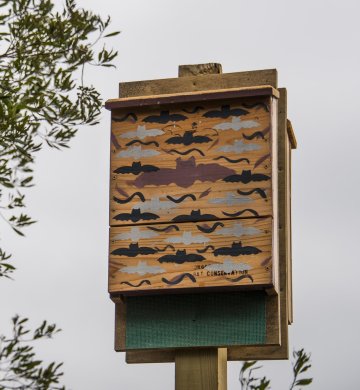Bats are nature’s own insect control program, often eating as many as a thousand bugs in an hour, per bat. Installing a bat house on your property can be a great way to clear your outdoor living space, and bats aren’t dangerous to humans at all. Only three of over a thousand species, worldwide, have any interest in mammalian blood. Bats don’t carry rabies more often than any wild animal. If you’ve decided to try this natural method of pest control you may be wondering how to attract bats to a bat house.
Select a house style

Bat houses improve community health by attracting bats that eat dangerous insects, including mosquitoes.
A number of factors go into successfully attracting bats to use a house. The design of the house is often overlooked, but it can be important. Bats won’t inhabit a space that doesn’t suit their needs, so a poorly designed house won’t give positive results. Kits are available on line, or from wildlife stores, but be sure they will attract the species of bats in your area. Books of plans can be purchased from the Organization of Bat Conservation, which contain information specific to types of bats.
Data collected by the Bat House Project indicates that vertical designs are preferred. In general, a large house is more likely to succeed because bats can move to different spaces that suit their temperature needs throughout the day. Large boxes also allow for separate nursery areas, which some species prefer.
Finishing your bat house
The color of the house matters, because the interior temperature matters. In northern states paint the house dark brown with a black roof. Bats prefer a temperature for roosting between 80-100 degrees Fahrenheit, and the dark color will absorb the rays of the sun. In southern states paint the box light brown and the roof white. In all cases, caulk the seams tightly.
Location is key
Bats, like any other type of wildlife, have needs and preferences. For food, some bats like fruits as well as insects. They need access to water and protection from predators. The location can also affect the internal temperature of the bat house.
Ideally, a bat house will be near a variety of habitats- open areas, woodlands, wetlands, and a water source. If there are fruits, such as berries or an old orchard nearby, so much the better. A slow stream, pond or lake no more than half a mile away is critical. Mounting the box on a pole or the side of a building are both good choices, much better than on a tree. Owls or hawks can also rest in a tree to prey on the bats. However, bats will want the box to be within 10-30 yards from forest cover where they can fly if they feel threatened.
If you are trying to move bats from a structure to a box, placing the box on an outside wall near their entrance to the building may improve the chance of success.
Make sure that there aren’t overhead wires, cables, or tree limbs near the box location.
In the north, the house should receive 6-8 hours of full sun each day, or it may not be warm enough inside. To maximize the benefit of the sunshine, face the box to the south. Angles to southeast or southwest are fine, to take better advantage of morning or afternoon sun. In the south, some shade might be necessary to maintain that ideal 100 degree internal temperature.
Keep in mind that when bats do begin to inhabit your box there will be guano and urine collecting underneath it. Don’t mount a box where this will be a constant problem for sanitation or aesthetics.
Height
Mount the box at least 12 feet above the ground. A maximum height is about 25 feet.
Timing can help
At the very least, you can expect to wait a year for bats to find a bat house. Bats can not be purchased. The only way to get them to live in your yard is to attract them there from another place. If you are trying to entice them to a box from inside your attic it may take less time than if you don’t already have an established colony. But it is common to wait two or three years for bats to find the home you are offering them.
The Bat House Project reported that even in urban areas 50% of bat houses were occupied after two years. They suggest that if your box hasn’t attracted any bats in that time, you should consider a relocation.
Providing a place for bats to make their home can be beneficial to both you and the animals. Most bats are threatened or endangered, and improving their habitat is a positive thing you can do to help restore the checks and balances of the planet.




